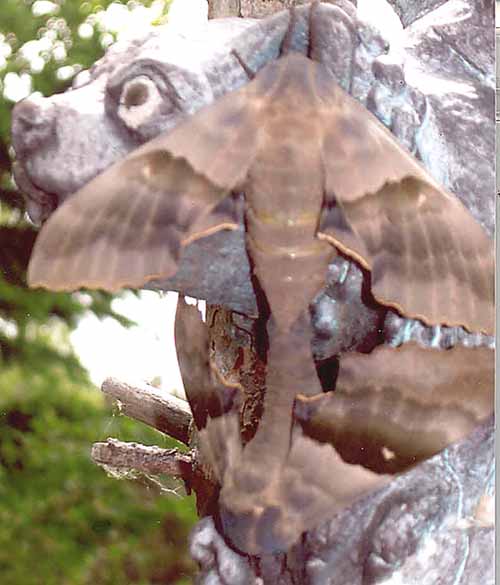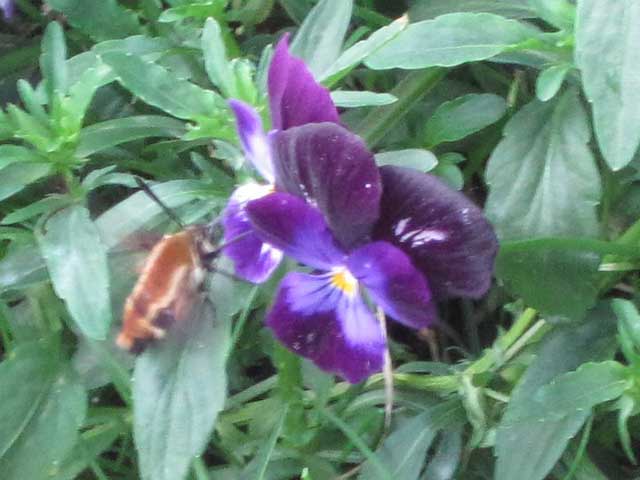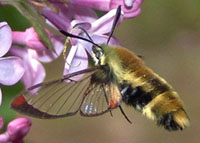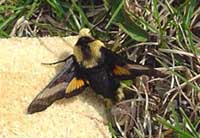|
|
Created/dedicated as per personal communication with Kelly Boedigheimer, June 2006
Updated as per personal communication with Scott Boutilier
Updated as per James P. Tuttle's The Hawk Moths of North America, December 7, 2012
Updated as per personal communication with Lisa Seliskar (Hemaris thysbe nectaring at Johnny Jump-ups, Britt, June, 2011); December 7, 2012
|
St. Louis County, Minnesota
Sphingidae

Pachysphinx modesta, pairing on gargoyle head,
Duluth, Minnesota, June 6, 2006, courtesy of Kelly Boedigheimer.
This page is inspired by and dedicated to
Kelly Boedigheimer who sent me the image and sigting data for
the Pachysphinx modesta pair from Duluth, St. Louis County.
Kelly writes, "I encountered these moths in my backyard in
Duluth, Minnesota, on June 6th, 2006. They were mating on my garden
gargoyle and were pretty big...probably 4-5 inches across the widest
part of the pic. I wish I'd taken out a ruler and set it near them.
Are they of the sphindidae species?"
Twelve Sphingidae species are listed for Minnesota on the U.S.G.S.
website. Not all of the species are reported or anticipated in
St. Louis County (only Hyles lineata is reported on U.S.G.S.
for St. Louis County). It is hoped that this
checklist, with the thumbnails and notes, will help you quickly
identify the moths you are likely to encounter.
A "WO" after the species name indicates that
I have no confirmed reports of this species in your county, but I
(William Oehlke) expect that this moth is present or
might be present. I have included many species not on the
USGS list for Minnesota; I believe they are or
might be present.
A "USGS" indicates the
moth is reported in Lepidoptera of North America,
#1. Distribution of Silkmoths (Saturniidae) and Hawkmoths (Sphingidae)
of Eastern North America,
an excellent little booklet available through Paul Opler.
Please help me develop this list with improved, documented accuracy by
sending sightings (species, date, location), preferably with an
electronic image, via email to
Bill Oehlke.
Scott Boutilier writes, "Here’s some data from the week of June 9-15
for St. Louis county Minnesota: P. modesta,
S. kalmiae,
C. undulosa,
S. luscitiosa,
D. myron,
D. pholus,
P. myops,
S. jamaicensis,
S. cerisyi."
Many thanks to Lisa Seliskar who provides the folllowing image of Hemaris diffinis.

Hemaris diffinis, Sand Lake, Britt, St. Louis County, Minnesota,
nectaring at Johnny Jump-ups, June 2011, courtesy of Lisa Seliskar.
Please also send your sightings to BAMONA, an excellent on-line resource.
Visit StLouis County Sphingidae Larvae: Caterpillars; Hornworms
Visit Minnesota Catocala: Underwing Moths
If you are travelling, you can find active Sphingidae checklists for all countries in North, Central, and South America and the Caribbbean via the links at
North, Central, South American Sphingidae checklists
Sphinginae subfamily
Sphingini tribe:
 |
Ceratomia amyntor
WO,
the Elm Sphinx or Four-horned Sphinx
The upperside of the forewing is brown with dark brown and white
markings including a white costal area near the wing base, dark
streaks along the veins, and a white spot in the cell.
Larvae feed on Elm (Ulmus), birch (Betula), basswood (Tilia), and cherry (Prunus). |
 |
It is named for the wavy lines on the forewings.
Note black and white collar separating thorax from abdomen. |
 |
Reported from northern Minnesota and central western Wisconsin,
it should be present in St. Louis County as well. This is one we have on P.E.I.
|
 |
Manduca quinquemaculatus
WO the Five-spotted Hawkmoth
The moth abdomen usually has five but sometimes six pairs of yellow
bands. The upperside of the forewing is blurry brown and gray. If
you grow tomatoes, you might encounter it.
|

|
Sphinx canadensis
WO,
Sphinx canadensis, the Canadian Sphinx, is not common, and is not
often reported anywhere.
The absence of the white spot on each forewing and the more
brownish coloration serve to separate canadensis from S. poecila.
Larval hosts are white ash (Fraxinus americana) and blueberry
(Vaccinium).
|
 |
Sphinx chersis
WO, the Northern Ash Sphinx or Great Ash
Sphinx
The upperside of the forewing is soft dark gray to
blue-gray with a series of black dashes, one of which reaches the
wing tip.
Larval hosts are ash, lilac, privet, cherry, and quaking aspen.
|
 |
Forewings, long and slender,
are held close to the body when the moth is at rest.
We have them on P.E.I., but I do not see them frequently.
|
 |
The lower forewings are predominantly brownish-yellow with a fairly
wide dark bar along the inner margin. At rest the wings hug the body,
giving the moth a long slender look.
|
 |
Sphinx luscitiosa
SB,
the Canadian Sphinx or
Clemen's Sphinx
This one is reported from St. Louis by Scott Boutilier.
|
 |
If you have blueberries in the woods, then you might have the Poecila
Sphinx. They are pretty common here on Prince Edward Island, but
don't fly too far west of Wisconsin. |
Smerinthini Tribe:
 |
This moth is also fairly widely reported to the east and south
and might be present.
This is the first Sphinx species I reared as a boy in New Jersey.
See the file for the female; she is different. |
 |
Pachysphinx modesta
KB/SB,
the Modest Sphinx or Poplar Sphinx
This moth is also found in Canada. Moths have very heavy bodies.
Larvae eat poplar and willow. |
Pachysphinx modesta, Duluth, Minnesota, June 6, 2006, Kelly Boedigheimer.
 |
Named for the dull grey-blue spot in the hindwing, this moth has a
very wide distribution.
I regularly see them on Prince Edward Island. |
 |
Paonias myops
WO/SB, the Small-eyed Sphinx
Named for the small eye-spot in the hindwing, this moth has a
very wide distribution.
I regularly see them on Prince Edward Island, and they are reported
as far south as Florida.
|
 |
Smerinthus cerisyi is found in the southern regions of all Canadian provinces and in northern border states. The One-eyed Sphinx is also found along
the U.S. west coast, eastward to the Rockies. At my home in Montague,
P.E.I., Canada, they are quite common. |
Smerinthus cerisyi, May 24, 2007, Scott Boutilier
 |
Smerinthus jamaicensis closely resembles Smerinthus cerisyi,
but jamaicensis is much smaller with larger blue patches on more
vibrant and deeper purple in the lower wings.
|
Macroglossinae subfamily
Dilophonotini tribe:
 |
Hemaris aethra
Note large orangey-brown forewing apical patch. In very similar H. diffinis patch is smaller.
On average H. aethra, compared to H. diffinis, tends to be slightly larger, with more orangey-yellow tone,
less tapering (top to bottom) of dark thorax/abdominal region; more red nr hw anal angle. possibly limited to northern Minnesota.
|
 |
Hemaris diffinis
WO/LS, the Snowberry Clearwing or Bumblebee Moth
This moth is widely distributed and is probably (confirmed by Lisa Seliskar) found in
St. Louis County.
|
Hemaris diffinis, Sand Lake, Britt, June 2011, courtesy of Lisa Seliskar.
See Hemaris comparison
 |
Hemaris gracilis WO, The Slender Clearwing or Graceful Clearwing:
This day flier is not commonly reported. |
 |
Hemaris thysbe
WO, the Hummingbird Clearwing
It is not difficult to see why many gardeners would mistake an Hemaris thysbe moth for a small hummingbird as it hovers, sipping nectar from flowers through a long feeding tube.
|
See Hemaris comparisons.
Macroglossini tribe:
 |
This day flier is widely distributed. If you have Virginia Creeper, you
probably have the Nessus Sphinx. Two bright, distinct, narrow yellow
bands are often visible on the abdomen.
|
 |
They are common in New Jersey and common
here on Prince Edward Island.
You will often see this species listed as Darapsa pholus,
especially in older literature. |
 |
Darapsa myron
WO/SB, the Virginia Creeper Sphinx or the
Grapevine Sphinx
If you have the foodplants indicated in the common names, you
might have this species nearby. The lower wings are orange.
|
|
 |
Hyles gallii
WO, the Bedstraw Hawk Moth
or Gallium Sphinx
This species is not reported in Minnesota on USGS, but I
suspect its presence in St. Louis County.
Some years I see them on P.E.I., some years, I do not.
|
 |
Hyles lineata
USGS, the White-lined Sphinx
This species is recorded in St. Louis County.
It is a strong migrator from the south, and probably appears
late summer or early fall. |
|
 |
Proserpinus flavofasciata WO, Yellow-banded Day Sphinx.
Medium to dark brown with faint to distinct white median band. Hw dark brown
with wide orange median band which may not reach inner margin. Moth mimics bumblebee.
Flies in afternoon as single brood from April-June in coniferous forest meadows. |
Enjoy some of nature's wonderments, giant silk moth cocoons.
These cocoons are for sale winter and fall. Beautiful Saturniidae moths will emerge the following spring and summer.
Read Actias luna rearing article. Additional online help available.
Use your browser "Back" button to return to the previous page.
This page is brought to you by
Bill Oehlke and the
WLSS. Pages are on space rented from Bizland. If you would like
to become a "Patron of the Sphingidae Site", contact Bill.
Please send sightings/images to Bill. I will do my best to respond to
requests for identification help.
 | 
Show appreciation for this site by clicking on flashing butterfly to the left.
The link will take you to a page with links to many insect sites. |
This website has been created and is maintained by Bill Oehlke without government or institutional financial assistance. All expenses, ie., text reference
support material, webspace rental from Bizland, computer repairs/replacements, backups systems, software for image adjustments (Adobe Photoshop; L-View),
ftp software, anti-virus protection, scanner, etc. are my own.
I very much appreciate all the many images that have been sent to me, or of which I have been granted permission to copy and post from other websites.
All images on this site remain the property of respective photographers.
If you would like to contribute to the maintenance of this website by sending a contribution to
Bill Oehlke
Box 476
155 Peardon Road
Montague, Prince Edward Island, C0A1R0
Canada
your donation would be much appreciated and would be used for
1) paying for webspace rental;
2) paying for computer maintenance and software upgrades;
3) purchases of additional text reference material (journals and books) in anticipation of expanding the site to a worldwide Sphingidae site;
4) helping to pay my daughter's tuition (completed
If you are mailing a check from USA, please use $1.25 postage (2018). Donations can also be made through Paypal via the button below.




